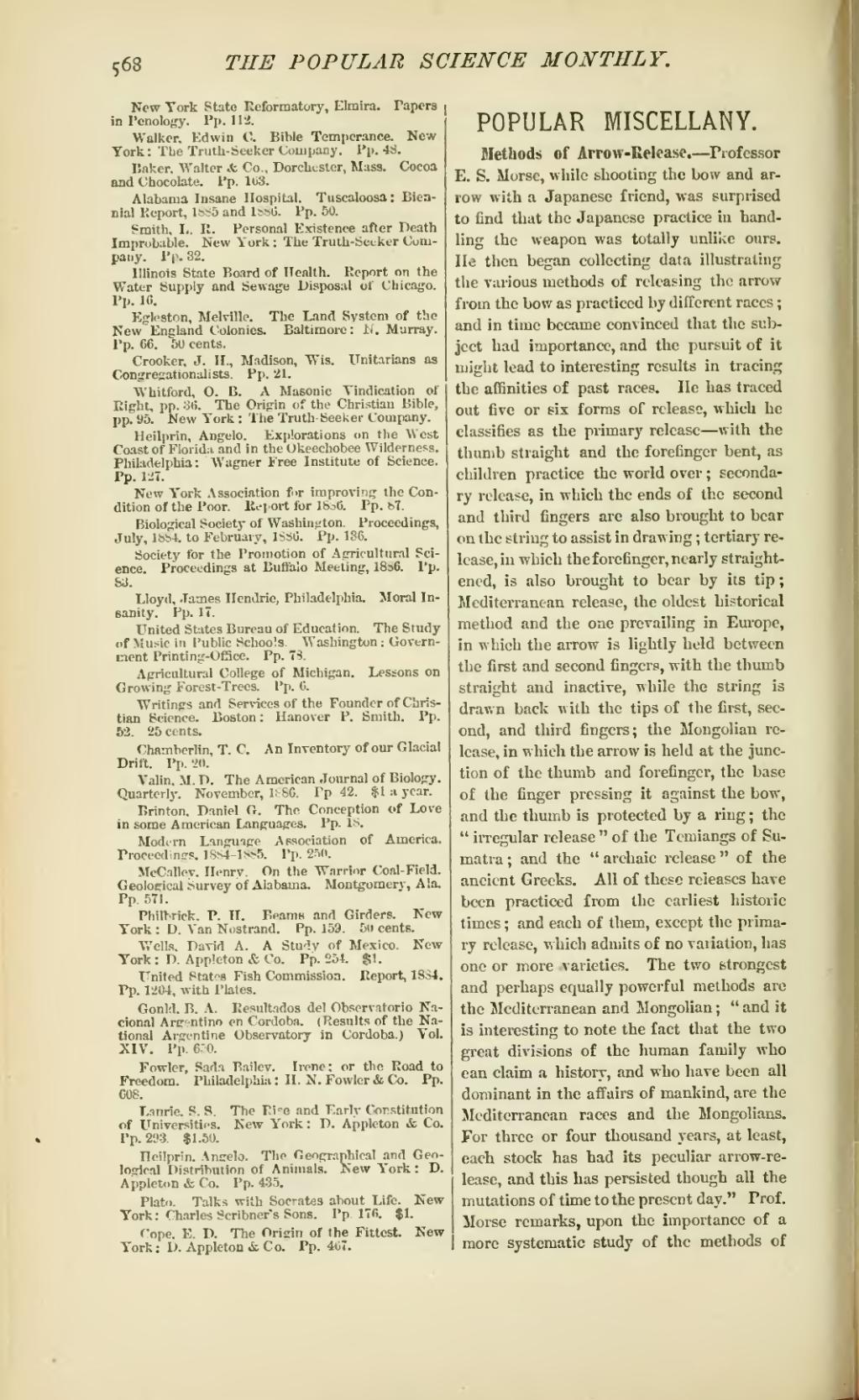New York State Reformatory, Elmira. Papers in Penology. Pp. 112.
Walker. Edwin C. Bible Temperance. New York: The Truth-Seeker Company. Pp. 48.
Baker. Walter & Co., Dorchester, Mass. Cocoa and Chocolate. Pp. 163.
Alabama Insane Hospital. Tuscaloosa: Biennial Report, 1885 and 1886. Pp. 50.
Smith, L. R. Personal Existence after Death Improbable. New York: The Truth-Seeker Company. Pp. 32.
Illinois State Board of Health. Report on the Water Supply and Sewage Disposal of Chicago. Pp. 16.
Egleston, Melville. The Land System of the New England Colonies. Baltimore: N. Murray. Pp. 66. 50 cents.
Crooker, J. H., Madison, Wis. Unitarians as Congregationalists. Pp. 21.
Whitford, O. B. A Masonic Vindication of Right, pp. 36. The Origin of the Christian Bible, pp. 95. New York: The Truth-Seeker Company.
Heilprin, Angelo. Explorations on the West Coast of Florida and in the Okeechobee Wilderness. Philadelphia: Wagner Free Institute of Science. Pp. 127.
New York Association for improving the Condition of the Poor. Report for 1886. Pp. 87.
Biological Society of Washington. Proceedings, July, 1884 to February, 1886. Pp. 186.
Society for the Promotion of Agricultural Science. Proceedings at Buffalo Meeting, 1836. Pp. 83.
Lloyd, James Hendrie, Philadelphia. Moral Insanity. Pp. 17.
United States Bureau of Education. The Study of Music in Public Schools, Washington: Government Printing-office. Pp. 78.
Agricultural College of Michigan. Lessons on Growing Forest-Trees. Pp. 6.
Writings and Services of the Founder of Christian Science. Boston: Hanover P. Smith. Pp. 52. 25 cents.
Chamberlin, T. C. An Inventory of our Glacial Drift. Pp. 20.
Valin. M.D. The American Journal of Biology. Quarterly. November, 1886. Pp 42. $1 a year.
Brinton. Daniel G. The Conception of Love in some American Languages. Pp. 18.
Modern Language Association of America. Proceedings. 1884-1885. Pp. 250.
McCalley Henry. On the Warrior Coal-Field. Geological Survey of Alabama. Montgomery, Ala. Pp. 571.
Philbrick, P. H. Beams and Girders. New York: D. Van Nostrand. Pp. 159. 50 cents.
Wells. David A. A Study of Mexico. New York: D. Appleton & Co. Pp. 254. §1.
United States Fish Commission. Report, 1884. Pp. 1204, with Plates.
Gould B. A. Resultados del Observatorio Nacional Argentino en Cordoba. (Results of the National Argentine Observatory in Cordoba.) Vol. XIV. Pp. 650.
Fowler, Sada Bailey. Irene; or the Road to Freedom. Philadelphia: H. N. Fowler & Co. Pp. 608.
Laurie. S. S. The Rise and Early Constitution of Universities. New York: D. Appleton &, Co. Pp. 293. $1.50.
Heilprin Angelo. The Geographical and Geological Distribution of Animals. New York: D. Appleton &. Co. Pp. 435.
Plato. Talks with Socrates about Life. New York: Charles Scribner's Sons. Pp. 176. $1.
Cope. E. D. The Origin of the Fittest. New York: D. Appleton & Co. Pp. 467.
Methods of Arrow-Release.—Professor E. S. Morse, while shooting the bow and arrow with a Japanese friend, was surprised to find that the Japanese practice in handling the weapon was totally unlike ours. He then began collecting data illustrating the various methods of releasing the arrow from the bow as practiced by different races; and in time became convinced that the subject had importance, and the pursuit of it might lead to interesting results in tracing the affinities of past races. lie has traced out five or six forms of release, which he classifies as the primary release—with the thumb straight and the forefinger bent, as children practice the world over; secondary release, in which the ends of the second and third fingers are also brought to bear on the string to assist in drawing; tertiary release, in which the forefinger, nearly straightened, is also brought to bear by its tip; Mediterranean release, the oldest historical method and the one prevailing in Europe, in which the arrow is lightly held between the first and second fingers, with the thumb straight and inactive, while the string is drawn back with the tips of the first, second, and third fingers; the Mongolian release, in which the arrow is held at the junction of the thumb and forefinger, the base of the finger pressing it against the bow, and the thumb is protected by a ring; the "irregular release" of the Temiangs of Sumatra; and the "archaic release" of the ancient Greeks. All of these releases have been practiced from the earliest historic times; and each of them, except the primary release, which admits of no variation, has one or more .varieties. The two strongest and perhaps equally powerful methods are the Mediterranean and Mongolian; "and it is interesting to note the fact that the two great divisions of the human family who can claim a history, and who have been all dominant in the affairs of mankind, are the Mediterranean races and the Mongolians. For three or four thousand years, at least, each stock has had its peculiar arrow-release, and this has persisted though all the mutations of time to the present day." Prof. Morse remarks, upon the importance of a more systematic study of the methods of
